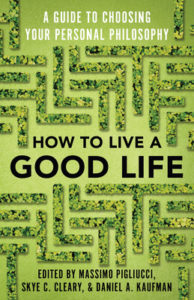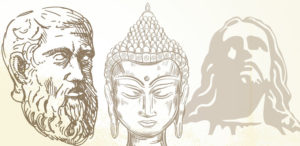How to Live a Good Life: A Guide to Choosing Your Personal Philosophy

EDITED BY MASSIMO PIGLIUCCI, SKYE C. CLEARY, AND DANIEL A. KAUFMAN
VINTAGE, 2020
How to Live a Good Life is not an overview of world religions and philosophies—rather, it’s intended to be an anthology that asks various philosophers to focus on why their particular worldview can be a guide to the good life. The editors don’t make a sharp distinction between philosophies of life and religions because they’re trying to get at how people build integrated views of life that guide them, support them, and give their lives meaning and purpose. It’s about the ways in which people look for that good life. Included are philosophies of Stoicism, Epicureanism, Buddhism, Christianity, Ethical Culture, effective altruism, and humanism.
Fifty years ago, if you wanted to learn about the world’s religions there was only one decent source, The World’s Religions by Huston Smith. Most other books were poorly written or academically narrow. It took some time for nonacademic, readable synopses of world religions to be published, but today everyone seems to know much more about world religions.
The bent in this particular book is towards humanistic if not overtly humanist philosophies. Even the chapter on Islam is by a self-described “progressive Muslim” who embraces religious pluralism, gender equality, science and reason, and a focus on human welfare. Therefore, while the book is not a compendium of all traditions as Smith’s book was, it doesn’t waste a humanist’s time dealing with the more pernicious aspects of religion. Focusing on humanist values, it illuminates different and interesting perspectives that will be easily appreciated by many card-carrying humanists.

Most of the traditions are well presented. The section on ancient philosophies from the East, covering Buddhism, Confucianism, and Daoism, is excellent as is the collection of essays looking at ancient philosophies from the West—Aristotelianism, Stoicism, and Epicureanism. The authors know their subjects and present their traditions in a good light. They offer insights that will be appreciated by most humanists.
The essays on Hinduism, Judaism, Christianity, Progressive Islam, and Ethical Culture (grouped as “Religious Traditions”) tend to approach their subjects more narrowly. This is to be expected as these religious traditions are broad and diverse. It’s been said there is no such thing as Christianity, for example, but rather “Christianities.” It’s hard to express the commonality of what a good life means to an evangelical Christian, a liberal Christian, a Mormon, a Catholic, or an Amish person as they are so different.
The final section on “Modern Philosophies” is generally good. I found the chapter on pragmatism, certainly the core of most humanist philosophy today, disappointing in its focus on the irrelevant suicidal temperament of both William James and Charles Pierce and for failing to express how a pragmatic outlook illuminates a non-foundationalist view committed to reason, ethics, and science. As a signer of the Humanist Manifesto, pragmatist John Dewey wrote, “We are looking for those ideals and ends so inclusive that they unify the self.” Dewey saw all our experiences as being involved in a “devotion to the ideal.” The healthy person unifies and harmonizes all their experiences into a whole life in that devotion to the ideal. We call it humanism.
This is exactly what the authors of this anthology seek to explore in all the philosophies they touch on. What helps unify a person? The great Islamic scholar Wilfred Cantwell Smith defines religion as what we ultimately rely on when all the chips are down. Yes, we may dally in many traditions, but what ultimately grounds us to achieve the good life, the ideal we would like to achieve?
I don’t think humanism is the only way to live the good life. We all know admirable people from various religious traditions. I do maintain that humanism is the best way, not just for us, but as a society to live the good life. But it isn’t for everybody and I accept that.
Almost all areas of thought are pretty much played out and the only way to grow a field is to bring in new ideas from outside the discipline. For example, the field of addiction expanded greatly when the ideas of evolutionary psychology were incorporated. Humanism is an evolving tradition. That’s why the Humanist Manifesto has been updated twice since 1933 (once in 1973 and again in 2003). I hope we have versions IV, V, and VI in the future. We always need new ideas.
A book like How to Live a Good Life allows us to listen to alternative voices outside our own tradition that may speak to our own worldview and help us grow. Many of these ideas have already been integrated with humanism, such as the Stoic concept of self-determination, the existentialist search for authenticity, Christian forgiveness, the Buddhist acceptance of suffering, and Confucianism’s focus on high character. While these concepts are now part of who we humanists are, hearing the original, more dedicated voices is helpful.
There is a danger in our modern syncretistic age of becoming superficial dilettantes, nervously moving back and forth between numerous ideas and never integrating them into a cohesive, coherent understanding of what’s true and how we should live our lives. The Germans call that kind of unifying understanding a Weltanschauung.
All religions and philosophies hope to present a coherent worldview, and those who embrace specific traditions will attest to their coherence. Of course, humanists would disagree that the basis for many religions is true and coherent. We hope our evolving worldview, our integrated life stance is coherent, and when it isn’t, that we adapt and revise our point of view.
I recommend this collection, especially the chapters on Buddhism and Stoicism. Along the path to understand others, it provides a mirror for us to explore our own beliefs, our own values, and what works just as the authors intended. It offers us a chance to ask what we’re doing to secure the good life for ourselves, others, and the planet at large.
